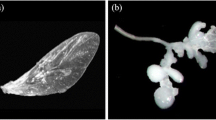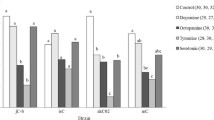Abstract
The number of eggs fertilized by a male at any given copulation (fertilization success) is affected by a large number of factors. Male insemination and sperm competition success and various female structures and/or processes that bias paternity in favor of some males over others (cryptic female choice) are all likely to affect fertilization success. We suggest that more comprehensive measures of male fertilization success can increase our understanding of postcopulatory sexual selection. To improve our understanding of the importance of various sources of variance in male fertilization success, we conducted a series of experiments using flour beetles. Different wild-type strains were used in reciprocal double mating experiments, against a phenotypic marker strain. We assessed the relative effects of female genotype, male genotype and mating order on independent and inclusive measures of male defense ability (P 1), male offense ability (P 2), and female remating behavior. Female genotype influenced both P 1 and P 2, and male genotype interacted strongly with female genotype in its effect on P 2. We also documented an interaction between female and male genotypes in the effects of mating on female remating behavior, such that females tended to remate most rapidly when mated to males of their own genotype. It is clear from our experiments that cryptic female choice influences the pattern of fertilization success in flour beetles, and we suggest that cryptic female choice may often be an important component of postcopulatory sexual selection. Future investigations would benefit from studying the multiple components of variance in male fertilization success.


Similar content being viewed by others
References
Andrés JA, Arnqvist G (2001) Genetic divergence of the seminal signal-receptor system in houseflies: the footprints of sexually antagonistic coevolution? Proc R Soc Lond B Biol Sci 268:399–405
Arnqvist G, Danielsson I (1999) Copulatory behavior, genital morphology and male fertilization success in water striders. Evolution 53:147–156
Arnqvist G, Edvardsson M, Friberg U, Nilsson T (2000) Sexual conflict promotes speciation in insects. Proc Natl Acad Sci USA 97:10460–10464
Bateson P (1983) Optimal outbreeding. In: Bateson P (ed) Mate choice. Cambridge University Press, Cambridge, pp 257–277
Beeman RW, Scott Thomson M, Clark JM, DeCamillis MA, Brown SJ, Denell RE (1996) Woot, and active gypsy-class retrotransposon in the flour beetle, Tribolium castaneum, is associated with a recent mutation. Genetics 143:417–426
Bernasconi G, Keller L (2001) Female polyandry affects their sons' reproductive success in the red flour beetle Tribolium castaneum. J Evol Biol 14:186–193
Birkhead TR (1998) Cryptic female choice: criteria for establishing female sperm choice. Evolution 52:1212–1218
Birkhead TR (2000) Defining and demonstrating postcopulatory female choice—again. Evolution 54:1057–1060
Birkhead TR, Møller AP (1998) Sperm competition and sexual selection. Academic, London
Bloch Qazi MC, Aprille JR, Lewis SM (1998) Female role in sperm storage in the red flour beetle, Tribolium castaneum. Comp Biochem Physiol 120:641–647
Boorman E, Parker GA (1976) Sperm (ejaculate) competition in Drosophila melanogaster, and the reproductive value of females to males in relation to female age and mating status. Ecol Entomol 1:145–155
Brown DV, Eady PE (2001) Functional incompatibility between the fertilization systems of two allopatric populations of Callosobruchus maculatus (Coleoptera: Bruchidae). Evolution 55:2257–2262
Burley N (1988) The differential-allocation hypothesis: an experimental test. Am Nat 132:611–628
Chapman T, Liddle LF, Kalb JM, Wolfner MF, Partridge L (1995) Cost of mating in Drosophila melanogaster females is mediated by male accessory gland products. Nature 373:241–244
Chapman T, Arnqvist G, Bangham J, Rowe L (2003) Sexual conflict. Trends Ecol Evol (in press)
Clark AG, Begun DJ (1998) Female genotype affect sperm displacement in Drosophila. Genetics 149:1487–1493
Clark AG, Aguade M, Prout T, Harshman LG, Langely CG (1995) Variation in sperm displacement and its association with accessory gland protein loci in Drosophila melanogaster. Genetics 139:189–201
Clark AG, Begun DJ, Prout T (1999) Female-male interactions in Drosophila sperm competition. Science 283:217–220
Crawley MJ (1993) GLIM for ecologists. Blackwell, Oxford
Eady PE (2001) Postcopulatory, prezygotic reproductive isolation. J Zool 253:47–52
Eberhard WG (1996) Female control: sexual selection by cryptic female choice. Princeton University Press, Princeton, NJ
Eberhard WG (2000) Criteria for demonstrating postcopulatory female choice. Evolution 54:1047–1050
Edvardsson M, Arnqvist G (2000) Copulatory courtship and cryptic female choice in red flour beetles Tribolium castaneum. Proc R Soc Lond B Biol Sci 267:559–563
Gavrilets S (2000) Rapid evolution of reproductive barriers driven by sexual conflict. Nature 403:886–889
Gavrilets S, Arnqvist G, Friberg U (2001) The evolution of female mate choice by sexual conflict. Proc R Soc Lond B Biol Sci 268:531–539
Gilchrist AS, Partridge L (1997) Heritability of pre-adult viability differences can explain apparent heritability of sperm displacement ability in Drosophila melanogaster. Proc R Soc Lond B Biol Sci 264:1271–1275
Howard DJ (1999) Conspecific sperm and pollen precedence and speciation. Annu Rev Ecol Syst 30:109–132
Kempenaers B, Foerster K, Questiau S, Robertson BC, Vermeirssen ELM (2000) Distinguishing between female sperm choice versus male sperm competition—a comment on Birkhead. Evolution 54:1050–1052
Lewis SM, Austad SN (1990) Sources of intraspecific variation in sperm precedence in red flour beetles. Am Nat 135:351–359
McCullagh P, Nedler JA (1989) Generalized linear models. Chapman & Hall, London
Nilsson T, Fricke C, Arnqvist G (2002) Patterns of divergence in the effect of mating on female reproductive performance in flour beetles. Evolution 56:111–120
Parker GA (1970) Sperm competition and its evolutionary consequences in the insects. Biol Rev 45:525–567
Parker GA, Partridge L (1998) Sexual conflict and speciation. Philos Trans R Soc Lond B 353:261–274
Pitnick S, Brown WD (2000) Criteria for demonstrating female sperm choice. Evolution 54:1052–1056
Pizzari T, Birkhead TR (2000) Female feral fowl eject sperm of subdominant males. Nature 405:787–789
Price CSC (1997) Conspecific sperm precedence in Drosophila. Nature 388:663–666
Reinhold K, Kurtz J, Engqvist L (2002) Cryptic male choice: sperm allocation strategies when female quality varies. J Evol Biol 15:201–209
Rice WR (1996) Sexually antagonistic male adaptation triggered by experimental arrest of female evolution. Nature 381:232–234
Rice WR (1998) Intergenomic conflict, interlocus antagonistic coevolution, and the evolution of reproductive isolation. In: Howard DJ, Berlocher SH (eds) Endless forms: species and speciation. Oxford University Press, New York, pp 279–288
Sheldon BC (2000) Differential allocation: tests, mechanisms and implications. Trends Ecol Evol 15:397–402
Simmons LW (2001) Sperm competition and its evolutionary consequences in the insects. Princeton University Press, Princeton
Simmons LW, Gwynne DT (1991) The refractory period of female katydids (Orthoptera, Tettigoniidae): sexual conflict over the remating interval? Behav Ecol 2:276–282
Smith RL (1984) Sperm competition and the evolution of animal mating systems. Academic, London
Sokoloff A (1972) The biology of Tribolium with special emphasis on genetic aspects, vol 1. Oxford University Press, Oxford
Sokoloff A, Slatis HM, Stanley J (1960) The black mutation in Tribolium castaneum. J Hered 51:131–135
Tadler (1999) Selection on a conspicuous male genetalic trait in the seedbug Lygaeus simulans. Proc R Soc Lond B Biol Sci 266:1773–1777
Telford SR, Jennions MD (1998) Establishing cryptic female choice in animals. Trends Ecol Evol 13:216–218
Thornhill R (1983) Cryptic female choice and its implications in the scorpionfly Harpobittacus nigriceps. Am Nat 122:765–788
Tregenza T, Wedell N (2002) Polyandrous females avoid costs of inbreeding. Nature 415:71–73
Wedell N, Gage MJG, Parker GA (2002) Sperm competition, male prudence and sperm-limited females. Trends Ecol Evol 17:313–320
Wilson N, Tubman SC, Eady PE, Robertson GW (1997) Female genotype affects male success in sperm competition. Proc R Soc Lond B Biol Sci 264:1491–1495
Acknowledgements
We are grateful to R.W. Beeman and M.S. Haas for providing the beetle stocks used, and for helping with practical advice. This study was made possible by the generous financial support of the Memory of J.C. Kempe Foundation (grant to T.N.), the DAAD Doktorandstipendium im Rahmen des gemeinsamen Hochschulsonderprogramms III von Bund und Ländern (fellowship to C.F.), and the Swedish Research Council (grant to G.A.).
Author information
Authors and Affiliations
Corresponding author
Additional information
Communicated by L. Simmons
Rights and permissions
About this article
Cite this article
Nilsson, T., Fricke, C. & Arnqvist, G. The effects of male and female genotype on variance in male fertilization success in the red flour beetle (Tribolium castaneum). Behav Ecol Sociobiol 53, 227–233 (2003). https://doi.org/10.1007/s00265-002-0565-0
Received:
Revised:
Accepted:
Published:
Issue Date:
DOI: https://doi.org/10.1007/s00265-002-0565-0




